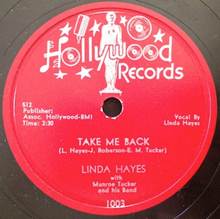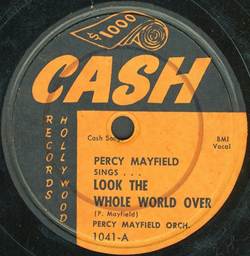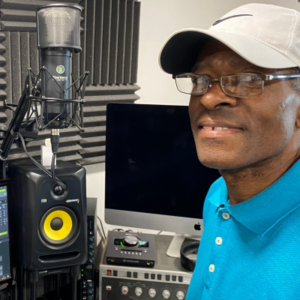The “Recorded In Hollywood” label was founded in Los Angeles in 1948 by John Dolphin, a Black record store entrepreneur. The operation was centred on the Dolphin’s of Hollywood record store in South Central LA, at the intersection of Vernon Avenue and Central Avenue, with recording and pressing facilities on site. It isn’t actually in Hollywood (it’s in Watts), but no-one seemed to mind. Dolphin’s explanation when this was mentioned was that his record label brought a flavour of Hollywood to the Black community.

John Dolphin (Wikimedia Commons)
Red Callender was appointed as Head of A & R, bringing his musical talent and many years of experience in the industry to the new label. He had joined Louis Armstrong’s band at the age of nineteen and had played with Nat King Cloe, Charlie Parker and many other Jazzmen, before turning to studio work. He became a member of the Wrecking Crew.
Dolphin decided to market the records he made from his Los Angeles store locally, which was obviously a limiting factor in terms of growing the business. However, most of the artists on the roster were well-known in and around the city, and a good profit could be made from selling a thousand copies of a single, as the overheads were kept to a minimum. Not using major distribution channels was a gamble, but Dolphin felt that his stores would generate the required sales.
Dolphin was not afraid to try new ideas to publicise his company’s output. He brought in local radio DJs to broadcast live from the shop’s front window. He also kept the shop open throughout the night at weekends. If a single showed signs of selling well, he then had the option of licensing tracks to other companies in other cities. Fees to musicians, songwriters and artists were kept to an absolute minimum (which was sometimes zero, as the fees were not paid!).

The target market for the company was the Black community of Los Angeles, but inevitably, given the local publicity and the all-night sessions, young White music-lovers turned up too. The police were frequent visitors to the store.
The genres of music that Recorded In Hollywood offered were the Race Records staples, Blues, Jazz, and Gospel, together with the emerging R&B styles, based on Boogie Woogie and Jump Blues. The best of the early releases is Percy Mayfield’s first single for the label, “Half Awoke”/ “Ten Years of Torture”, with backing from the Monroe Tucker Orchestra. The B-side is a slow Blues, but the A-side is a more up-tempo R&B vocal.

The roster was built up to around twenty acts, with a few well-known names such as Percy Mayfield, Jimmy Grissom (who had recorded at Roy Milton’s labels) and Jesse Belvin. The majority of the releases were, however, by local youngsters who were hoping to break into the industry. They were attracted by the speed at which Dolphin could record and press their songs and then get them played on the local radio station. Typical of these youngsters were the Hollywood Four Flames, who cut two singles with Dolphin in 1951. The quality of the vocals is not great, but they lived in hope! They were followed by Gene Forrest, Little Caesar, and Bobby Nunn, whose “Christmas Bells” from 1952 is an account of his loneliness as his girl has gone away!
One of the successes on the label came from Linda Hayes, with her single “Yes I Know”, which she recorded with Red Callender (bass), Maxwell Davis (tenor sax), Floyd Turnham (baritone sax), Monroe Tucker (piano) and Chico Hamilton (drums) in 1953.

Linda Hayes
The song reached number two on the Billboard R&B Singles Chart. It is a catchy, up-tempo dance track, typical of the new R&B style, that suited Hayes’ powerful vocals perfectly. Hayes was born in Linden, New Jersey, in 1923. Her real name was Bertha Lulu Williams; she was the sister of Tony Williams, lead singer with the Platters. A follow-up single, “Big City”, is a slow Blues. It failed to chart.
In the summer of 1951, Dolphin had leased a couple of dozen masters to King Records in Cincinnati. He could also look back on several strong local hits, but during 1952 the business started to struggle. In 1953, he took the decision to sell all the masters to Decca Records. The record label was sold separately to Don Pierce of Starday Records, who swiftly changed the name to Hollywood Records. The sale didn’t mark the end of Dolphin’s activities in the record market, however, as he had set up five subsidiary labels, to which he now devoted his time. They main ones were named Cash Records, Money records, and Lucky Records. Pierce also acquired the rights to several Swing Time recordings, having concluded a deal with Jack Lauderdale, which saw singles by Lowell Fulson, Charles Brown and Mabel Scott released on the Hollywood label. The design of the new label has a hint of Swing Time too!

The first big seller on Hollywood was Linda Hayes’ “Take Me Back”, which sold 150,000 copies. It is a slow ballad that Hayes infuses with a sense of swing, and it provides another good example of what Los Angeles R&B was all about. Hayes made five more singles for Hollywood, before the company relocated to Madison, Tennessee.
Meanwhile, John Dolphin was building up his remaining labels. He switched his focus to the White market and aimed at more Pop styles. There were, however, still hints of his earlier ventures into R&B. In 1956, Percy Mayfield’s “Look The Whole World Over” was released on Cash.

More indicative of Dolphin’s new approach was the Turbans’ “When I Return”, backed by the Turks’ “Emily”, issued on the Money label in 1955, with their sweeping Doo-Wop sound.

Dolphin ran the labels until 1st February 1958, when he was killed in his record store by a part-time employee called Percy Ivy. Ivy had written some songs which he had sold to Dolphin. When no payment was forthcoming, Ivy took his revenge. Dolphin’s wife Ruth later resurrected the Money label.
















